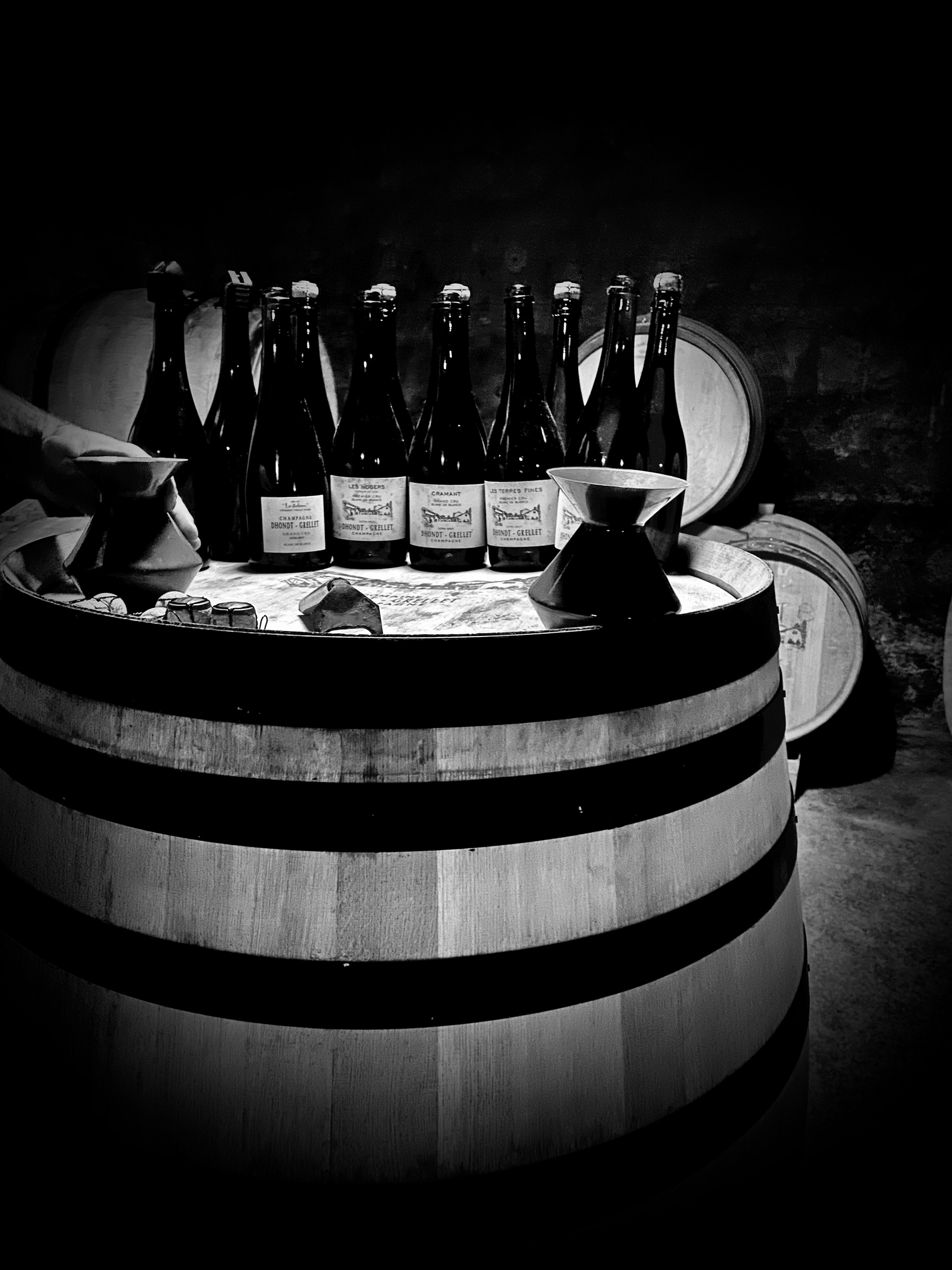Dhondt-Grellet
Flavigny ~ Cote des Blancs
I’ve always been a contemplative and reflective person. Often, I find myself lost in my own thoughts completely unaware of my surroundings. Truthfully, I enjoy this. I love leaving an experience feeling full of inspiration. This happens frequently in Champagne, and our visit to Dhondt-Grellet was one of those experiences. This is where the idea for “Pagne in the Glass: A New Generation of Champagne Producers & Consumers” originated. It developed throughout our trip, but this visit was the catalyst that initiated our further observations.
The Discovery
We learned early in our wine life to turn the bottle around and read the back label if it was a wine we didn’t already know. There were a few importers whose wines we enjoyed and began noticing that we liked much of what was in their portfolio. This also helped somms and retail shops guide us to new wines that continued to expand our wine knowledge. This is how we found Dhondt-Grellet. On our most recent trip to Champagne I really wanted to visit some producers I did not already know. I had seen Dhondt-Grellet in other markets, and their label had become very recognizable, but I didn’t much about them or their wines. I did, however, know several of the wines in this specific importer’s portfolio and perused their website for new ideas. Two producers caught my attention and upon further research I added them to my list of possible visits. In fact, I added them very close to the top. This was slightly outside of our comfort zone. We like a very distinct plan and organize things in a way that allow little room for disappointment. With Champagne, however, my approach is quite the opposite. I have enjoyed letting things come in a more organic nature and allowing myself the freedom to go where it may lead. So far, it has been an exciting, wonderful, and unexpected ride.
The Visit
Dhondt-Grellet is located in Flavigny, a tiny village east of Avize, with the hills of the Cote des Blancs in the background. We have always felt this moment of anxiety upon arriving at a new winery. We call it the “awkward moment.” You’re never really sure if you’re in the correct place, if the person with whom you are scheduled to meet will remember or will actually be available, or if you will be able to easily communicate. Many of these small wineries are located at or very near the producers’ homes which at times can feel a bit intrusive - like you’re invading a special and private place. This is amplified when you know nothing about the domaine, the wines, or the producer.
Adrien Dhondt, however, made this awkward moment disappear very quickly. We also have a rule when traveling that we rarely say no. When a winemaker begins a sentence with “Would you like to…” we always say yes. There are some situations in which we will ask for specific things to taste or see, but mostly we want to be guided by the producer. What do they want to show us and what do they want us to taste? He led us into the cellar where he has an upturned barrel set up for tastings. From this vantage point one can see a few additional rooms/passages in the cellar lined with barrels and other production areas. We visited very soon after harvest, so the cellar was quite busy, and we were not able to get a true sense of the size. However, Adrien spent at least an hour or more telling us about the history of the family, the domaine, and his “new” approach to winemaking. By new, Adrien, like many other young generation wine makers in Champagne, are altering the way their families’ wines are produced. They learned from their parents and grandparents, many spent time studying in other wine regions, and all are drawing on their own experiences and preferences to make a wine that reflects their individual style, even if that differs from that of their parents. What was even more surprising to me is how much support they have from the previous generations. When the next generation takes over, their families seem to support their decisions and help them through the transition.
The Wines
When we arrived, Adrien had five bottles ready for us to taste. As we’ve seen with many younger winemakers, Dhondt-Grellet is using oak during the wine making process along with a perpetual reserve that dates back to 1986 (the beginning of the domaine). The use of oak in champagne as well as the use of a perpetual reserve produces a more oxidative wine. We really enjoy this oxidative style of champagne and Dhondt-Grellet have become some our favorite wines that we continue to seek out at home.
During our visit we tasted:
Dans un Premier Temps, NV - Dhondt-Grellet uses grapes from three villages in their wine, Avenay, Cuis, and Sezanne. Dans un Premier Temps represents a blend of these villages. 50% Chardonnay from Sezanne, 30% Pinot Noir from Avenay, and 20% Meunier from Cuis. 70% of the blend is dedicated to the base vintage/30% of the blend comes from the family’s perpetual reserve.
Les Terres Fines 1er Cru Blanc de Blancs, NV - 100% Chardonnay from Cuis. 70% base vintage/30% perpetual reserve. Brut Nature
Cramant, NV - 100% Chardonnay from Cramant (Grand Cru)
Les Nogers - The lieu dit of Les Nogers is technically in Cuis, although it is located on the same hill as Le Bateau in Cramant. 100% Chardonnay from a single vineyard
Le Bateau Cramant Grand Cru - A single vineyard Blanc de Blancs planted by Adrien’s great-grandfather in Cramant.


